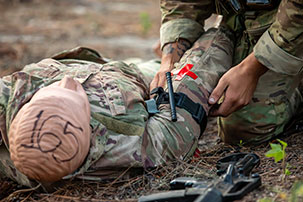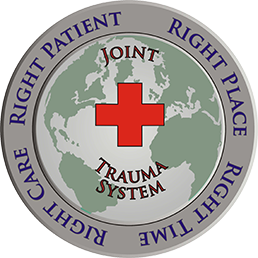Joint Trauma Education and Training (JTET) Branch
JTET Mission: To ensure Armed Forces combat casualty care personnel maintain readiness and are able to be deployed rapidly for future armed conflicts.
JTET Responsibilities
- Facilitate and coordinate partnerships with civilian medical centers and large metropolitan teaching hospitals to promote the sharing of patient care experiences to build knowledge, skills, and abilities (KSAs) required for combat casualty care teams.
- Develop a formal process for the exchange of lessons learned between military and civilian organizations.
- In collaboration with the military departments (MILDEPs), uses a systematic approach to acquire lessons learned from civilian partnerships.
- Incorporates the lessons learned information (from both military and civilian) into clinical practice guidelines.
- Develops standardized combat casualty care instruction for all members of the Armed Forces.
- Collaborates with Defense Health Agency (DHA) leadership and Secretaries of the MILDEPs to develop combat casualty care instruction for all members of the Armed Forces, to include standardized curricula, guidelines and training tools.
- Recommends updates to relevant initial and continuing education courses based on established standards of care, KSAs, and emerging evidence-based casualty care initiatives.
- Helps identify combat casualty care outcome measures, which can improve patient survival and outcomes.
- Serves as a point of contact for combat casualty care education and training inquiries. Send inquiries to: dha.jbsa.healthcare-ops.list.jts-jtet@health.mil
In the future, JTET will work to standardize mobile medical team trainings to be consistent across the MILDEPs and incorporate trauma caseload requirements into standardized training requirements.
Knowledge, Skills, and Abilities
Register for the KSA Knowledge Assessments at the Joint Knowledge, Skills, and Abilities hub here.
ICTL: Individual Critical Task Lists
ICTLs focus on skills identified by the U.S. Army for the maintenance of combat readiness in each medical military occupational specialty (MOS), including physicians. ICTL lists are available at the Central Army Registry. CAC is required. To display a list of desired ICTL, enter the specialties' MOS code into the topic in the search bar (e.g. 68W for a combat medic).

Click here to view the Who Does Not Need a Tourniquet Presentation »
Readiness Training
There are 3 pre-deployment courses. Each course consists of multiple tiers or modules for different types of providers.
Course #1 — Tactical Combat Casualty Care
Tier #1 — All Service Members
Tier #2 — Combat Life Saver
Tier #3 — Combat Medic
Tier #4 — Combat Paramedic - coming soon Instructor/Trainer Tools for Tactical Combat Casualty Care
Course #2 — Prolonged Field Care
(under development)
Tier #1 — None
Tier #2 — Combat Life Saver
Tier #3 — Combat Medic
Tier #4 — Combat Paramedic
Course #3 — Emergency War Surgery Course (EWSC) aka JTS CPG Curricula
Click here to learn more about the collection and registration.
Module #1 — Advanced Surgical Skills for Exposure in Trauma (ASSET)+
Audience: General Surgeons and Subspecialties, those who assist them, and Surgical Technicians.
Module #2 — Combat Orthopedic Trauma Surgery (COTS)+
Audience: Orthopedic Surgeons, those who assist them, and Surgical Technicians.
Module #3 — Expeditionary Skills Course for General Medical Officers:
These are the Army Individual Critical Task List and the Air Force Comprehensive Medical Readiness Program.
Audience: any specialty that may deploy in the role of a general medical officer and includes Family Practice, Internal Medicine and Subspecialties, Pediatrics and Subspecialties, Physician Assistants, Nurse Practitioners, and (likely) Special Operations Medics.
Module #4 — (under development) — Head and Neck Course.
Audience: Ears, Nose, and Throat Surgeons, Oral Maxillofacial Surgeons, and Plastic Surgeons, those who assist them, and Surgical Technicians.
Module #5 — (under development) — Anesthesia.
Audience: Anesthesiologists and Nurse Anesthetists.
Module #6 — (under development) — Critical Care/Emergency Medicine Nursing.
Audience: Critical Care and Emergency Medicine Nursing, possibly Med/Surgery, Operative, Peri-operative, and other deployable nursing specialties.

